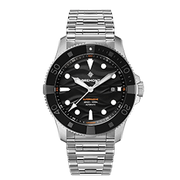The vessel struck a mine in the early hours of 8th May and nearly 90 men perished in what has been known as one of the worst naval disasters of the second world war. Only nine of the vessel’s crew members survived after swimming seven miles back to shore in cold water.
The spot where the 283-foot-long submarine sank in the Mediterranean Sea was a mystery for 70 years and was only discovered in 2011 using side-scan sonar technology to survey the seabed. This was a project in which Timmy Gambin was heavily involved as the archaeological director of the Aurora Trust, a team of expert divers.
2017 marks the 75th anniversary of the wreck and to mark the occasion Timmy led an international dive team to descend 115 meters to the site where they laid a memorial plaque by the shipwreck. A monument was also unveiled to honour those who were lost overlooking the former Royal Navy submarine base off Manoel Island, Malta.
Bremont has been making specialised dive watches since its very early days. These chronometers, designed to be over-engineered in all respects were quickly adopted by the military and diving community. Timmy and his team wore watches from the Bremont Supermarine collection to take part in the dive, all of which will be auctioned to raise money for the HMS Olympus Memorial Project.
Bremont Co-Founder, Giles English: "HMS Olympus was the largest submariner loss of life ever from the Royal Navy and now the wreck has been discovered we felt that it was very important that we help remember those that were lost with a fitting memorial. Bremont does a lot of work with the armed forces and the Royal Navy so it was an obvious fit to support our long term ambassador Timmy Gambin with this special project.”
Timmy Gambin: "Mission accomplished - the team completed every planned assignment to commemorate the 75th anniversary of the sinking of HMS Olympus. Descending to -115 meters, our team placed a specially-made memorial plaque on the shipwreck and unfurled a White Ensign in remembrance of the 89 young men who lost their lives. It was an extremely poignant and moving moment in the deep and silent Mediterranean Sea. Our Bremont timepieces were an integral part of our setup - ensuring that the dive teams worked within the strict time parameters necessary with such extreme diving”.
You can make a donation to support the dive to lay the plaque and set up the monument here: https://www.justgiving.com/cro...
ABOUT HMS OLYMPUS
HMS Olympus was built by Beardmore Shipyards on the Clyde River in Glasgow where numerous other warships had been constructed. She was part of the O or Odin Class submarine, the first submarine to be designed and built after World War One. This class of submarine measured 84 meters in length and nine meters at the beam. It had a displacement of 1700 tons on the surface and 2030 tons submerged. Leaving the harbour in the dark on the morning of 8 May 1942 she is recorded to have headed eastwards so as to avoid mines that were systematically laid across the approaches to Grand Harbour. A couple of hours later a large bang was heard by those on board and crewmembers automatically assumed that their vessel was under attack and scrambled to dive the submarine. Despite the obvious confusion on board it soon became evident that the submarine was taking water and there was little that could be done to save her. Within a few minutes water started splashing over the sides and all men were instructed to abandon ship and jump overboard. Looking back, one of nine survivors recalls how the Olympus sank gracefully ‘on her last dive’ under the waves. She took with her between 10 and 20 men from the P39 as these were trapped in the battery section of the vessel.














